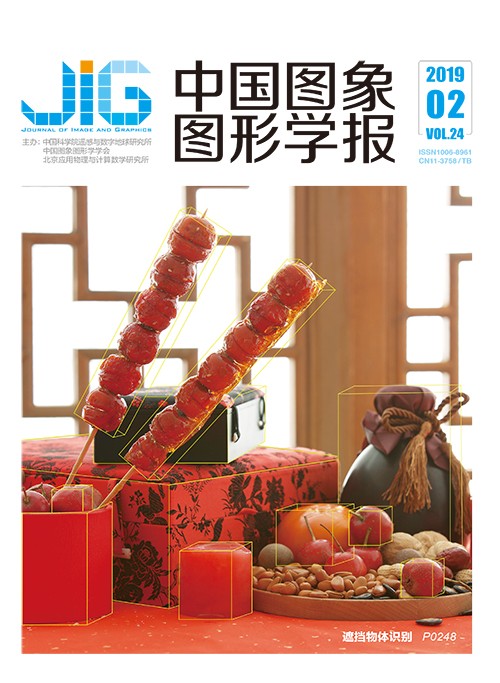
高质量快速全景场景再现技术
摘 要
目的 色彩纠正和图像融合是生成高质量全景场景图像的关键技术。色彩纠正中参考图像的选择以及图像融合算法,决定着所生成全景图像的质量和速度。现有方法在确定一幅图像是否适合作为参考图像时,需要遍历所有其他图像,计算其作为参考图像进行色彩纠正的效果,复杂度高,速度慢;在图像融合时存在融合质量与融合速度之间的矛盾。因此,如何快速生成高质量的全景图像就成为全景场景再现的主要诉求。为此本文提出优化的参考图像自动选择的色彩纠正方法和基于重叠区域划分的分区融合方法。方法 针对参考图像选择算法复杂度高的问题,根据图像质量与稳定性通常呈反比关系的事实,采用贪婪策略,选择质量最差的图像在色彩纠正前后的相似度,作为是否选择当前图像作为参考图像的评价指标,在保证参考图像满足色彩纠正需求的前提下,大幅降低计算复杂度。针对融合质量与融合速度之间的矛盾,提出分区融合:将重叠区域划分为接缝区域和非接缝区域,利用泊松融合的接缝不可见性和线性融合实现速度快的特性分别对接缝区域和非接缝区域进行融合,既保证融合的质量,又加快融合速度。在此基础上,加入简单点光源,解决上述过程产生的光线一致性问题,进一步提高图像质量。结果 采用主观和客观相结合的方法对结果进行评估。主观方面,本文算法生成的全景图像色彩基本实现平滑过渡且图像原始信息保留完整。客观方面,色彩纠正前后图像的结构相似度(SSIM)控制在0.850.99之间,时间复杂度由原来的O(n2)降低到O(n);分区融合后图像信息熵接近于泊松融合,但时间消耗降低72%。采用基于PC端的问卷调查法和OG-IQA算法将本文算法与PTGui、OpenCV、Xiong方法生成的全景图质量进行对比,在大多数情况下本文算法均优于上述算法。结论 实验表明,本文算法适用于多种场景,在保证目视效果良好的前提下,时间消耗降低,可广泛应用于医学、数字旅游、遥感等领域。
关键词
High-quality and fast panoramic scene reproduction
Li Hong, Song Chunhua, Niu Baoning(College of Information and Computer, Taiyuan University of Technology, Jinzhong 030600, China) Abstract
Objective Panorama scene reproduction, which is widely used in medicine, tourism, remote sensing, and photography, is a technique utilized to produce a large or wide-angle scene with multiple overlapping images. Color correction and image blending are the key issues in the generation of high-quality panoramas. The generation efficiency and quality are primarily determined by selecting a reference image for color correction and an image blending algorithm. To determine a reference image, state-of-the-art methods compare the similarity of all target images, which is computationally complex with poor real-time responsiveness. In addition, a contradiction exists between the quality and speed in image blending. Therefore, a high-quality panoramic image should be rapidly generated to reproduce panoramic scenes. Method A key task for a panorama stitching technique is finding the optimal seams in the overlap region of the source image, merging them along the seam, and minimizing the seam artifact. This study presents an efficient method in selecting a reference image for color correction and a partition blending method that differentiates the overlapping area. The color and illumination of images are inconsistent due to the difference in camera equipment, shooting angle, and shooting time, which affect the visual quality of the panorama. Color correction is applied to reduce the color difference between images and accelerate the optimal seam search and image blending processes. Color correction uses a reference image to adjust the color style of other images. In other words, the reference image determines the quality of the final panorama. The panoramic image may suffer from blurriness, inappropriate brightness, and low contrast when the quality of the selected reference image is poor. The quality of an image is usually inversely proportional to the stability of an image; thus, a greedy strategy is adopted to determine the best reference image and reduce the computational complexity. The worst quality image is selected as the baseline, which is determined based on the relative standard deviation of the image pixels of adjacent images. The similarity between the original and corrected baselines is used to determine whether an input image is appropriate to be used as the reference image, such that the complexity for selecting a reference image is remarkably reduced while guaranteeing the need for color correction. An effective color correction method can achieve a smooth transition of the panoramic image. However, an unnatural transition along the seam is observed. Image blending is required to conceal the artifacts, in which Poisson and linear blending are usually used. Linear blending is simple and fast. However, the weakness of linear blending is that stitching artifacts may be visible after the blending. In comparison with linear blending, Poisson blending is more effective although it is more time-consuming than the former. Partition blending is proposed to solve the following problems. The overlapping region is divided into seam and non-seam regions, Poisson blending is performed in the seam region, and linear correction is conducted in the non-seam region to obtain a high-quality image. A simple point-light source is added to solve the light inconsistency generated by the aforementioned processes and improve the quality of the panorama. Result Subjective and objective evaluations show interesting results for the proposed method. For the subjective evaluation, the methods can produce a panoramic scene with consistent color styles and can maintain the original details. For the objective evaluation, the structural similarity of the image after color correction is controlled between 0.85 and 0.99, the time complexity is reduced to O(n) from the original O(n2), the image information entropy is close to Poisson blending after the partition blending, and the time consumption is 72% lower than that of its original. In addition, we use a PC-based questionnaire method and an OG-IQA algorithm to compare the quality of the panorama generated by PTGui, OpenCV, Xiong's method, and our proposed method. Results show that our proposed method performs best in most cases. Conclusion Experiments demonstrate that our proposed method works well in various scenarios. The time consumption is reduced and good visual effect is ensured, and the method can be widely used in medicine, digital tourism, remote sensing, and other fields.
Keywords
panoramic scene reproduction reference image color correction image blending region division local light
|



 中国图象图形学报 │ 京ICP备05080539号-4 │ 本系统由
中国图象图形学报 │ 京ICP备05080539号-4 │ 本系统由